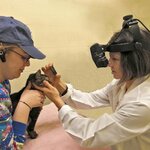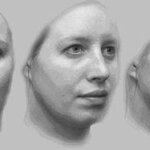Vision

Humans excel at recognizing faces, but how we do this has been an abiding mystery in neuroscience and psychology. In an effort to explain our success in this area, researchers are taking a closer look at how and why we fail.
A new study from MIT looks at a particularly striking instance of failure: our impaired ability to recognize faces in photographic negatives. The study, which appears in the Proceedings of the National Academy of Sciences this week, suggests that a large part of the answer might lie in the brain's reliance on a certain kind of image feature.
The work could…

About one in 3,500 people are affected with retinitis pigmentosa (RP), a disease of the retina's visual cells that eventually leads to blindness. Now, a University of Missouri researcher has identified a genetic link between cats and humans for two different forms of RP. This discovery will help scientists develop gene-based therapies that will benefit both cats and humans.
Researchers examined the genetic mutations in two groups of cats; one with a congenital form of RP and another with a late-onset form and were able to identify the genes responsible for both forms of the disease in…

There's another reason to dust off those running shoes. Vigorous exercise may help prevent vision loss, according to a pair of studies from the U.S. Department of Energy's Lawrence Berkeley National Laboratory. The studies tracked approximately 31,000 runners for more than seven years, and found that running reduced the risk of both cataracts and age-related macular degeneration.
The research, which is among the first to suggest that vigorous exercise may help prevent vision loss, offers hope for people seeking to fend off the onset of eye disease.
"In addition to obtaining…

Scientists have known for more than 200 years that vision begins with a series of chemical reactions when light strikes the retina, but the specific chemical processes have largely been a mystery. A team of researchers from the United States and Switzerland say they have shed new light on this process by "capturing" this chemical communication for future study and say it may lead to the development of new treatments for some forms of blindness and vision disorders.
At the center of the discovery is the signaling of rhodopsin to transducin. Rhodopsin is a pigment in the eye that helps…

Imaging systems, artificial intelligence and computer programs for facial recognition could get a boost by work from Dr. Adrian Dyer of Monash University, one of Australia's leading bee experts - he says his latest research shows that honeybees can learn to recognize human faces even when seen from different viewpoints.
The findings show that despite the highly constrained neural resources of the insects (their brains are 0.01 per cent the size of the human brain) their ability has evolved so that they're able to process complex visual recognition tasks.
The researchers…

A team of Johns Hopkins neuroscientists has worked out how some newly discovered light sensors in the eye detect light and communicate with the brain. The report appears online this week in Nature.
These light sensors are a small number of nerve cells in the retina that contain melanopsin molecules. Unlike conventional light-sensing cells in the retina—rods and cones—melanopsin-containing cells are not used for seeing images; instead, they monitor light levels to adjust the body's clock and control constriction of the pupils in the eye, among other functions.
"These melanopsin-…

How electrical traffic is routed through the brain has always been of great interest to psychologists. It was once thought that electrical signals always followed set paths through the brain, much in the way the heart pushes blood through the cardiovascular system. Many signals do, in fact, follow the same paths over and over again, but what is now more generally understood is that these pathways are in no way hardwired. The plasticity of the brain, or its ability to change based on the needs of the organism, has now been verified using a number of independent experiments. Scientists have now…

A future episode of CSI or your favorite crime drama may have an interesting new way to establish time of death, thanks to the work of a team of researchers from the University of Santiago de Compostela. Based on the analysis of several substances from the vitreous humour of the eye of cadavers, they write in the journal Statistics in Medicine, they have developed a piece of software that makes it possible to establish precisely the post mortem interval (PMI), information that will make the work of the police and the courts of justice easier.
To apply this technique the…

Children whose eyes are misaligned and point outward are at significantly increased risk of developing mental illness by early adulthood, according to findings of a Mayo Clinic study published this month in Pediatrics (http://pediatrics.aappublications.org/cgi/content/full/122/5/1033), the official journal of the American Academy of Pediatrics.
The retrospective study examined the medical records of 407 patients with strabismus (misaligned eyes) and compared them with records of children matched for age and sex but with normal eye alignment. Children with eyes that diverged (exotropia) were…

By manipulating the appearance of a chronically achy hand, researchers have found they could increase or decrease the pain and swelling in patients moving their symptomatic limbs. The findings in Current Biology reveal a profound top-down effect of body image on body tissues, according to the researchers.
In the study, the researchers asked ten right-handed patients with chronic pain and dysfunction in one arm to watch their own arm while they performed a standardized set of ten hand movements. The participants repeated the movements under four conditions: with no visual manipulation, while…